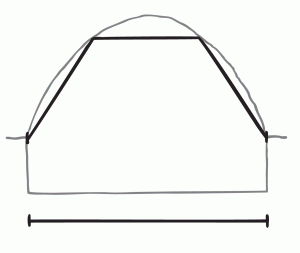If you have free access to the materials required to build a hugel (logs, sticks, mulch), it’s much cheaper and easier than any other form of water efficient garden bed.
Benefits
What are the advantages of using hugelkultur over other gardening or permaculture techniques?
The main benefits of Hugelkultur beds are that they are water efficient and cheap to build if you have the right resources (lots of trees nearby).
With Hugelkultur you’re mimicking the forest’s natural soil making mechanisms.
Besides being water efficient, using local resources, and providing a perfect environment for worms and beneficial micro organisms,
In addition, hugels provide a lot of visual interest in the garden.
The advantages of Hugelkultur:
- Cheap and easy
- Improved water efficiency
- No need to turn or till the soil. Minimises weeding
- Use up rotting wood, twigs, branches and even whole trees that would otherwise go to the dump or be burned
- Extended growing season due to the heat generated by the composting wood.
- Increased surface area: approx 1.5 – 2 times as much growing area, depending on the height of your hugels.
- Excellent drainage and conditions for most plants
- Microclimates (sun trap on the northern/sun side, shaded on the other side).
Excellent environment for worms, mycelium and other soil microbes.
Water efficient
I estimate that you can save around 40% of your water resources using hugel beds. From watering every day for five minutes, you can deep water a hugel for twenty minutes each week, even at the height of summer.
I’ve pushed it to watering once a fortnight in mid-summer, but this is not ideal for plant vigour.
Cheap and easy
The first is that if you have access to the raw materials, it’s cheap and requires very little skill to build. In comparison to a wicking bed system, maintenance is optional and there’s not much that can go wrong with a hugelkultur bed.
Increased surface area
Depending on the type of hugel you build you increase the surface area of your bed.
 A traditional hugel can provide nearly double the growing space of a conventional bed. For a hugel with a 120cm base, the optimum growing area is at least 240cm.
A traditional hugel can provide nearly double the growing space of a conventional bed. For a hugel with a 120cm base, the optimum growing area is at least 240cm.
A typical sunken hugel increases the surface area by half. For a hugel with a 120cm base that is raised 60cm above ground level, the optimum growing area is at least 180cm.
Excellent growing conditions

Hugels provide excellent growing conditions for a range of plants.
- The northern side of the hugel provides a sun trap.
- The top of a traditional or sunken hugel provides drier, well-drained soils.
- Towards the base of the hugel are conditions for more water hungry plants.
Beneficial soil environment
 Hugels provide a beneficial environment for fungus and mycelium as the wood in the hugel rots. Worms love hugels, and because you have a range of rotting materials, varied food sources, air pockets, wetter areas, and drier areas, you provide habitats for beneficial microorganisms.
Hugels provide a beneficial environment for fungus and mycelium as the wood in the hugel rots. Worms love hugels, and because you have a range of rotting materials, varied food sources, air pockets, wetter areas, and drier areas, you provide habitats for beneficial microorganisms.
No till, minimal weeding
Because of the structure of the hugel bed, you should not till a hugel. I recommend applying a top dressing annually, and add to the woody matter to keep your hugels at the ideal height (but this is optional). Your hugels will also require little weeding in comparison to a conventional bed.
When not to build Hugelkultur beds
Hugels are not right for all applications.
I recently visited a friend’s place where she had experimented with Hugelkultur, but had not had any significant improvement, and said that in fact the hugels were not water efficient, but were rather drier than the rest of her garden. Her property was converted land fill, and she could not dig down into the fill. I suspect that the lack of good soil beneath the hugels meant that she needed to compensate by building very tall hugels and adding a lot of worms. Additionally she did not have access to a lot of organic materials, and building hugels meant shipping in large amounts of resources.
Build hugels when:
- You have decent soil structure beneath the hugel (not land fill).
- You have access to a mix of free logs, sticks, leaves, woodchips and grass and garden clippings. Having to buy or ship these long distances will make hugel building an expensive enterprise.
- You are willing to put in a lot of work up front, with minimum maintenance at a later date.
Build hugels if you have free access to most of the raw materials. Buying or shipping these materials in can be expensive.
Don’t build if you have poor soil structure beneath or on top of land fill.
And I don’t recommend building on steep a slope in place of swales, without the use of retaining walls.


